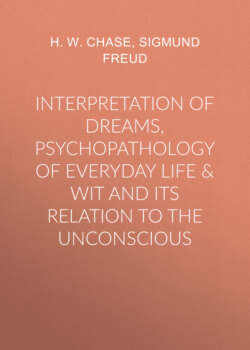Оглавление
H. W. Chase. The Unconscious
The Unconscious
Reading suggestions
Table of Contents
THE INTERPRETATION OF DREAMS
INTRODUCTORY REMARKS
PREFACE TO THE SECOND EDITION
PREFACE TO THE THIRD EDITION
TRANSLATOR'S PREFACE
I. THE SCIENTIFIC LITERATURE ON THE PROBLEMS OF THE DREAM1
II. METHOD OF DREAM INTERPRETATION. THE ANALYSIS OF A SAMPLE DREAM
III. THE DREAM IS THE FULFILMENT OF A WISH
IV. DISTORTION IN DREAMS
V. THE MATERIAL AND SOURCES OF DREAMS
VI. THE DREAM-WORK
VII. THE PSYCHOLOGY OF THE DREAM ACTIVITIES
PSYCHOPATHOLOGY OF EVERYDAY LIFE
INTRODUCTION
I. FORGETTING OF PROPER NAMES
II. FORGETTING OF FOREIGN WORDS
III. FORGETTING OF NAMES AND ORDER OF WORDS
IV. CHILDHOOD AND CONCEALING MEMORIES
V. MISTAKES IN SPEECH
VI. MISTAKES IN READING AND WRITING
A. Lapses in Reading
B. Lapses in Writing
VII. FORGETTING OF IMPRESSIONS AND RESOLUTIONS
A. Forgetting of Impressions and Knowledge
B. Forgetting of Intentions
VIII. ERRONEOUSLY CARRIED-OUT ACTIONS
IX. SYMPTOMATIC AND CHANCE ACTIONS
X. ERRORS
XI. COMBINED FAULTY ACTS
XII. DETERMINISM—CHANCE—AND SUPERSTITIOUS BELIEFS
WIT AND ITS RELATION TO THE UNCONSCIOUS
TRANSLATOR’S PREFACE
A. ANALYSIS OF WIT
A. ANALYSIS OF WIT. I. INTRODUCTION
A. ANALYSIS OF WIT. II. THE TECHNIQUE OF WIT
A. ANALYSIS OF WIT. III. THE TENDENCIES OF WIT
B. SYNTHESIS OF WIT
B. SYNTHESIS OF WIT. IV. THE PLEASURE MECHANISM AND THE PSYCHOGENESIS OF WIT
B. SYNTHESIS OF WIT. V. THE MOTIVES OF WIT AND WIT AS A SOCIAL PROCESS
C. THEORIES OF WIT
C. THEORIES OF WIT. VI. THE RELATION OF WIT TO DREAMS AND TO THE UNCONSCIOUS
C. THEORIES OF WIT. VII. WIT AND THE VARIOUS FORMS OF THE COMIC
FREUD'S THEORIES OF THE UNCONSCIOUS. by H. W. Chase
Отрывок из книги
Sigmund Freud, H. W. Chase
PSYCHOPATHOLOGY OF EVERYDAY LIFE
.....
Delbœuf16 reaches the same conclusion through a somewhat different line of argument. We give to the dream pictures the credence of reality because in sleep we have no other impressions to compare them with, because we are cut off from the outer world. But it is not perhaps because we are unable to make tests in our sleep, that we believe in the truth of our hallucinations. The dream may delude us with all these tests, it may make us believe that we may touch the rose that we see in the dream, and still we only dream. According to Delbœuf there is no valid criterion to show whether something is a dream or a conscious reality, except—and that only in practical generality—the fact of awakening. "I declare delusional everything that is experienced between the period of falling asleep and awakening, if I notice on awakening that I lie in my bed undressed" (p. 84). "I have considered the dream pictures real during sleep in consequence of the mental habit, which cannot be put to sleep, of perceiving an outer world with which I can contrast my ego."9
As the deviation from the outer world is taken as the stamp for the most striking characteristics of the dream, it will be worth while mentioning some ingenious observations of old Burdach8 which will throw light on the relation of the sleeping mind to the outer world and at the same time serve to prevent us from over-estimating the above deductions. "Sleep results only under the condition," says Burdach, "that the mind is not excited by sensory stimuli... but it is not the lack of sensory stimuli that conditions sleep, but rather a lack of interest for the same; some sensory impressions are even necessary in so far as they serve to calm the mind; thus the miller can fall asleep only when he hears the rattling of his mill, and he who finds it necessary to burn a light at night, as a matter of precaution, cannot fall asleep in the dark" (p. 457).
.....
